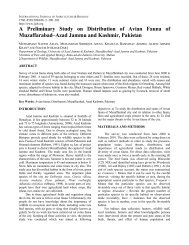Distribution of Freshwater Turtles in Punjab, Pakistan - the Wildlife of ...
Distribution of Freshwater Turtles in Punjab, Pakistan - the Wildlife of ...
Distribution of Freshwater Turtles in Punjab, Pakistan - the Wildlife of ...
You also want an ePaper? Increase the reach of your titles
YUMPU automatically turns print PDFs into web optimized ePapers that Google loves.
Caspian J. Env. Sci. 2006, Vol. 4 No. 2 pp. 142~ 146<br />
©Copyright by The University <strong>of</strong> Guilan, Pr<strong>in</strong>ted <strong>in</strong> I.R. Iran<br />
[Research]<br />
CJES<br />
Caspian Journal <strong>of</strong> Environmental Sciences<br />
<strong>Distribution</strong> <strong>of</strong> <strong>Freshwater</strong> <strong>Turtles</strong> <strong>in</strong> <strong>Punjab</strong>, <strong>Pakistan</strong><br />
Muhammad Akbar 1 , Muhammad Mushtaq-ul-Hassan, 2 * and Zaib –u-Nisa 2<br />
1- <strong>Punjab</strong> <strong>Wildlife</strong> Research Institute, Gatwala, Faisalabad, <strong>Pakistan</strong><br />
2- Department <strong>of</strong> Zoology, Government College University, Faisalabad.<br />
*Correspond<strong>in</strong>g Author’s E-mail: drmushtaqulhassan@hotmail.com<br />
ABSTRACT<br />
A total <strong>of</strong> 3528 specimens <strong>of</strong> freshwater turtles belong<strong>in</strong>g to two families viz., Geoemydidae (Brown River<br />
Turtle, Kachuga smithi; Indian Saw-backed turtle, K. tecta; Brahm<strong>in</strong>y Rrive Turtle, Hardella thurgi; Spotted<br />
Pond Turtle, Geoclemys hamiltonii) and Trionychidae (Indian S<strong>of</strong>t-shell Turtle, Aspederates gangeticus;<br />
Peacock S<strong>of</strong>t-shell Turtle, A.hurum; Narrow-headed S<strong>of</strong>t-shell Turtle, Chitra <strong>in</strong>dica; Indian Flap-shell Turtle,<br />
Lissemys punciata) were identified. Kachuga smithi (43.62%) and K.tecta (42.06%) had abundant population<br />
status, whereas, Hardella thurgi (0.88%) and Chitra <strong>in</strong>dica (0.54%) were rare. Captur<strong>in</strong>g <strong>of</strong> turtles for supply<br />
to foreigners and export is a major threat to <strong>the</strong>se animals. Fishermen also kill <strong>the</strong>m dur<strong>in</strong>g fish<strong>in</strong>g. Canal<br />
closure and de-silt<strong>in</strong>g is also harmful to turtles. It is concluded that it is necessary to provide immediate<br />
legal protection/coverage to all turtle species under <strong>the</strong> <strong>Punjab</strong> <strong>Wildlife</strong> Act, 1974, <strong>Pakistan</strong>; o<strong>the</strong>rwise<br />
turtle species will become ext<strong>in</strong>ct.<br />
Keywords: Turtle, Population, <strong>Distribution</strong>, Species, Captur<strong>in</strong>g, Rivers, Canals, Protection, and Management.<br />
INTRODUCTION<br />
The order Chelonia is <strong>in</strong> <strong>the</strong> class<br />
Reptilia and conta<strong>in</strong>s 13 recognized<br />
families. These <strong>in</strong>clude land tortoises,<br />
freshwater and mar<strong>in</strong>e turtles. There are<br />
about 289 liv<strong>in</strong>g species <strong>of</strong> turtles and<br />
tortoises, which are found <strong>in</strong> different<br />
habitat <strong>of</strong> <strong>the</strong> world (Ernst et al. 2005).<br />
Some genera are distributed very<br />
widely but o<strong>the</strong>rs are restricted to icelands<br />
or small cont<strong>in</strong>ental areas. Two families <strong>of</strong><br />
freshwater turtles, namely, Geoemydidae<br />
and Trionychidae occur <strong>in</strong> <strong>the</strong> rivers <strong>of</strong> <strong>the</strong><br />
<strong>Punjab</strong>, <strong>Pakistan</strong>. Turtle populations are<br />
be<strong>in</strong>g rapidly deleted as <strong>the</strong>y are not<br />
protected or conserved by any Government<br />
Depart-ment <strong>in</strong> <strong>Pakistan</strong>. These animals do<br />
not have any legal protection/ coverage<br />
through any Law or Act. Consequently<br />
some species populations are becom<strong>in</strong>g<br />
threatened. The Ganges s<strong>of</strong>t-shell turtle,<br />
Peacock s<strong>of</strong>t-shell turtle, Spotted pond<br />
turtle, and <strong>the</strong> Indian saw-backed turtle are<br />
<strong>in</strong>cluded <strong>in</strong> Appendix-I, whereas, Indian<br />
flap-shell turtle is <strong>in</strong>cluded <strong>in</strong> Appendix-II<br />
<strong>of</strong> <strong>the</strong> Convention on International Trade <strong>in</strong><br />
Endangered Species (CITES) (Anonymous,<br />
2005). The Indian S<strong>of</strong>t-shell Turtle,<br />
Brahm<strong>in</strong>y Turtle and Smith’s terrap<strong>in</strong> are<br />
non-CITES (Anonymous, 2005).<br />
No research work has been conducted<br />
on freshwater turtles <strong>in</strong> <strong>Pakistan</strong> so basic<br />
data on occurrence and population<br />
distribution <strong>of</strong> different species is not<br />
available. Rub<strong>in</strong> et al. (1998) stressed that<br />
accurate knowledge about spatial distribution<br />
<strong>of</strong> a species or population is essential<br />
for effective management <strong>in</strong> <strong>the</strong> natural<br />
habitat.<br />
The objective <strong>of</strong> this study was to<br />
determ<strong>in</strong>e <strong>the</strong> population distribution and<br />
status <strong>of</strong> freshwater turtle species <strong>in</strong> <strong>the</strong><br />
<strong>Punjab</strong> (<strong>Pakistan</strong>) and to submit a proposal<br />
to Government to take appropriate decision<br />
regard<strong>in</strong>g export <strong>of</strong> turtles on a susta<strong>in</strong>able<br />
basis and to provide legal protection to<br />
threatened species.<br />
MATERIAL AND METODS<br />
o Five rivers <strong>of</strong> <strong>the</strong> <strong>Punjab</strong> and seven<br />
irrigation canals were surveyed form 19<br />
different po<strong>in</strong>ts as shown <strong>in</strong> Table1 Fig. 1.<br />
These places were randomly selected for<br />
study, but were readily accessible. The stu-<br />
Onl<strong>in</strong>e version is available on www.cjes.net
Muhammad Akbar, Muhammad Mushtaq-ul-Hassan , Zaib –u-Nisa 143<br />
dy was conducted from December 2003 to<br />
April 2004 us<strong>in</strong>g <strong>the</strong> flow<strong>in</strong>g procedure.<br />
o Bask<strong>in</strong>g turtles were observed,<br />
directly counted and different species were<br />
identified with <strong>the</strong> help <strong>of</strong> B<strong>in</strong>ocular M<strong>in</strong>olta<br />
(10x50 mm).<br />
o No turtle was found bask<strong>in</strong>g dur<strong>in</strong>g<br />
severe cold wea<strong>the</strong>r conditions so drag net<br />
was used for captur<strong>in</strong>g <strong>of</strong> turtles. Netted<br />
animals were counted; <strong>the</strong>ir species<br />
identified and <strong>the</strong>n released back <strong>in</strong>to <strong>the</strong><br />
same water.<br />
o Canals were surveyed, dur<strong>in</strong>g canal<br />
closure season, by walk<strong>in</strong>g <strong>in</strong> dry canals<br />
o<br />
follow<strong>in</strong>g <strong>the</strong> flipper pr<strong>in</strong>ts <strong>of</strong> turtles.<br />
Animals found above ground <strong>in</strong> <strong>the</strong> dry<br />
canal were identified to species and<br />
counted, whereas <strong>the</strong> animals hibernated /<br />
buried <strong>in</strong> dried canal bed were removed<br />
from <strong>the</strong> bed, identified and counted.<br />
o A third method used baited hooks<br />
to capture turtles and was particularly good<br />
for catch<strong>in</strong>g s<strong>of</strong>t-shell turtles. Steel hooks<br />
were baited with <strong>in</strong>test<strong>in</strong>e <strong>of</strong> poultry. After<br />
species identification and count<strong>in</strong>g, turtles<br />
were released back <strong>in</strong> <strong>the</strong>ir natural habitat.<br />
For species identification M<strong>in</strong>ton (1966) was<br />
followed.<br />
Site<br />
#<br />
Fig. 1 The study region with <strong>the</strong> sampl<strong>in</strong>g sites <strong>of</strong> Fresh water turtle <strong>in</strong> <strong>Punjab</strong>, <strong>Pakistan</strong><br />
Name <strong>of</strong> Locality<br />
Site<br />
#<br />
Name <strong>of</strong> Locality<br />
Site<br />
#<br />
Name <strong>of</strong> Locality<br />
1 Head Qadirabad (chenab) 2 Head Trimmu (Chenab) 3 Head Marla (chenab)<br />
4 Qadierabad-Balloki l<strong>in</strong>k canal<br />
5 Upper Chenab canal (Chenab) 6 Rangpur canal (Chenab)<br />
(Chenab)<br />
7 Ch<strong>in</strong>ot river (Chenab) 8 Head Rasool (Jhelum) 9 Sangoi area river (Jhelum)<br />
10 Chasma Barrage (Indus) 11 Taunsa Barrage (Indus) 13 Kallorkot river ( Indus)<br />
14 Head Islam (Satluj) 15 Qaim canal (Satluj) 16 Pakpattan canal (satluj)<br />
17 Fordwah canal (Satluj) 18 Sadiqia canal (Satluj) 19 Head Balloki (Ravi)<br />
RESULTS AND DISCUTIONS<br />
A total <strong>of</strong> 3528 <strong>in</strong>dividual turtles<br />
belong<strong>in</strong>g to two families viz., Geoemydidae<br />
(Brown River Turtle, Kachuga smithi; Indian<br />
Saw-backed turtle, K. tecta; Brahm<strong>in</strong>y Rrive<br />
Turtle, Hardella thurgi; Spotted Pond Turtle,<br />
Geoclemys hamiltonii) and Trionychid-ae<br />
(Indian S<strong>of</strong>t-shell Turtle, Aspederates<br />
gangeticus; Peacock S<strong>of</strong>t-shell Turtle,<br />
A.hurum; Narrow-headed S<strong>of</strong>t-shell Turtle,<br />
Chitra <strong>in</strong>dica; Indian Flap-shell Turtle,<br />
Lissemys punciata) were identified (Table 1).
144<br />
<strong>Distribution</strong> <strong>of</strong> <strong>Freshwater</strong> <strong>in</strong> <strong>Pakistan</strong><br />
Sr#.<br />
1<br />
2<br />
3<br />
4<br />
5<br />
6<br />
7<br />
8<br />
9<br />
10<br />
11<br />
12<br />
13<br />
14<br />
15<br />
16<br />
17<br />
18<br />
19<br />
Table 1. Population <strong>Distribution</strong> <strong>of</strong> <strong>Freshwater</strong> <strong>Turtles</strong> <strong>in</strong> <strong>the</strong> <strong>Punjab</strong> (<strong>Pakistan</strong>).<br />
Name <strong>of</strong><br />
Approx.<br />
area<br />
Number <strong>of</strong> animals observed<br />
Locality<br />
Surveyed K. K. H. G.<br />
A.<br />
(River)<br />
(km) smithi tecta thurgi hamiltoni gangeticus<br />
Head<br />
Qadirabad<br />
(Chenab)<br />
Head<br />
Trimmu<br />
(Chenab)<br />
Head<br />
Marala<br />
(Chenab)<br />
Qadirabad-<br />
Balloki<br />
l<strong>in</strong>k canal<br />
(Chenab)<br />
Upper<br />
Chenab<br />
canal<br />
(Chenab)<br />
Rangpur<br />
canal<br />
(Chenab)<br />
Ch<strong>in</strong>iot,<br />
river<br />
(Chenab)<br />
Head<br />
Rasool<br />
(Jhelum)<br />
Sangoi<br />
area,<br />
river<br />
(Jhelum)<br />
Chashma<br />
Barrage<br />
(Indus)<br />
Taunsa<br />
Barrage<br />
(Indus)<br />
Kallorkot,<br />
river<br />
(Indus )<br />
Dera<br />
Ismail<br />
Khan,<br />
river<br />
(Indus)<br />
Head<br />
Islam<br />
(Satluj)<br />
Qaim canal<br />
(Satluj)<br />
Pakpattan<br />
canal<br />
(Satluj)<br />
Fordwah<br />
canal<br />
(Satluj)<br />
Sadqia<br />
canal<br />
(Satlij)<br />
Head<br />
Balloki<br />
(Ravi)<br />
A.<br />
hurrum<br />
C.<br />
<strong>in</strong>dica<br />
L.<br />
punctata<br />
Date<br />
<strong>of</strong><br />
Survey<br />
31-12-<br />
03<br />
& 07-<br />
03-04 9 114 149 0 1 22 16 0 0 302 8.56<br />
23-01-<br />
04<br />
& 29-<br />
03-04 3 572 588 31 3 27 15 2 0 1238 35.09<br />
13<br />
& 14-<br />
01-04 1 12 18 0 6 6 0 0 42 1.19<br />
30-12-<br />
03 30 7 12 0 0 7 1 0 7 34 0.96<br />
12-1-<br />
2004 20 20 16 0 1 8 1 0 27 73 2.07<br />
29-03-<br />
04 1 26 40 0 0 6 4 0 0 76 2.15<br />
23<br />
& 24-<br />
12-03 1 1 4 0 0 3 0 8 16 0.45<br />
02-01-<br />
04<br />
& 09-<br />
03-04 2 5 7 0 0 6 3 0 3 24 0.68<br />
10-3-<br />
2004 1 12 15 0 0 12 8 1 7 55 1.56<br />
13-02-<br />
04<br />
& 26-<br />
03-04 5 139 119 0 46 27 10 2 0 343 9.72<br />
20-12-<br />
03<br />
& 28-<br />
03-04 3 347 284 0 1 27 16 5 0 680 19.27<br />
14-02-<br />
04 3 77 69 0 0 18 6 0 0 170 4.82<br />
15-02-<br />
04<br />
& 27-<br />
03-04 10 95 68 0 4 51 26 1 0 245 6.94<br />
15-01-<br />
04 1 3 5 0 0 1 0 0 0 9 0.26<br />
15-01-<br />
04 0.5 4 2 0 0 1 0 0 0 7 0.20<br />
17-01-<br />
04 0.5 3 2 0 0 1 0 0 0 6 0.17<br />
17-01-<br />
04 0.5 4 2 0 0 1 0 0 0 7 0.20<br />
17-01-<br />
04 0.5 3 4 0 0 1 0 0 0 8 0.23<br />
30-04-<br />
04 1 95 80 0 0 6 3 8 1 193 5.47<br />
Total > 93 1539 1484 31 62 231 109 19 53 3528<br />
% 43.62 42.06 0.88 1.76 6.55 3.09 0.54 1.50<br />
Total<br />
%
Muhammad Akbar, Muhammad Mushtaq-ul-Hassan , Zaib –u-Nisa 145<br />
The most abundant species found was<br />
Kachuga smithi (43.62%) followed by Kachuga<br />
tecta (42.06%). The status <strong>of</strong> Hardella thurgi<br />
and Chitra <strong>in</strong>dica was rare (0.88% and 0.54%,<br />
respectively), whereas <strong>the</strong> status <strong>of</strong><br />
Geoclemys hamiltonii (1.76%) Aspederates<br />
hurum (3.09%) and Lissemys punciata (1.50%)<br />
frequent. Aspederates gangeticus was<br />
common (6.55%). Ofall <strong>the</strong> sites sampled,<br />
<strong>the</strong> breatest numbers and species diversity<br />
was recorded at Head Trimmu (35.09% <strong>of</strong> all<br />
captures) belong<strong>in</strong>g to seven different<br />
species. It is <strong>the</strong> place where two rivers i.e.,<br />
Chenab and Jhelum jo<strong>in</strong> toge<strong>the</strong>r. Maximum<br />
population was recorded <strong>in</strong> Rangpur canal,<br />
which flows from Head Trimmu (2.15%)<br />
(Table 1).<br />
Khan (1999) reported <strong>the</strong> distribution <strong>of</strong><br />
Agrionemys horsfedii <strong>in</strong> Balochistan and not<br />
<strong>in</strong> <strong>Punjab</strong>. Dur<strong>in</strong>g <strong>the</strong> present study it was<br />
aga<strong>in</strong> not recorded <strong>in</strong> <strong>the</strong> <strong>Punjab</strong>. Suwelo<br />
(2001) reported that <strong>the</strong> tortoises, terrap<strong>in</strong>s<br />
and turtles <strong>of</strong> Sou<strong>the</strong>ast Asia have been<br />
harvested from <strong>the</strong> wild for a wide range <strong>of</strong><br />
purposes, primarily for food and traditional<br />
Ch<strong>in</strong>ese medic<strong>in</strong>e, but also for pets and to<br />
release <strong>in</strong> Buddhist sites <strong>in</strong> temples. Jetk<strong>in</strong>s<br />
(1995) reported that <strong>in</strong> recent years <strong>the</strong> trade<br />
has escalated and changed dramatically.<br />
Once predom<strong>in</strong>antly for local consumption,<br />
<strong>the</strong> harvest is now motivated by<br />
<strong>in</strong>ternational demand, primarily <strong>in</strong> East Asia<br />
and particularly ma<strong>in</strong>land Ch<strong>in</strong>a. A<br />
dramatic <strong>in</strong>crease <strong>in</strong> exports to Ma<strong>in</strong>land<br />
Ch<strong>in</strong>a dates from <strong>the</strong> time when <strong>the</strong> Ch<strong>in</strong>ese<br />
currency became convertible.<br />
Dur<strong>in</strong>g our study some threats to turtles<br />
population was also recorded which are<br />
given below <strong>in</strong> order <strong>of</strong> <strong>the</strong>ir magnitude.<br />
1. <strong>Freshwater</strong> turtles do not have any<br />
legal protection coverage through any<br />
prov<strong>in</strong>cial Act; <strong>the</strong>refore, <strong>the</strong>y are be<strong>in</strong>g<br />
captured <strong>in</strong> thousands for supply to<br />
foreigners liv<strong>in</strong>g <strong>in</strong> <strong>Pakistan</strong> and to illegal<br />
export for supply to abroad. Reports <strong>of</strong><br />
captur<strong>in</strong>g turtles on large scale were<br />
received from Chashma Barrage, Taunsa<br />
Barrage, Head Qadirabad, Head Rasool,<br />
Head Trimmu, Head Balloki and Ch<strong>in</strong>iot<br />
area.<br />
2. Fishermen also capture turtles<br />
dur<strong>in</strong>g fish<strong>in</strong>g with nets and angl<strong>in</strong>g. Some<br />
turtles are accidentally killed with nets,<br />
whereas some fishermen considered <strong>the</strong>m<br />
<strong>the</strong> enemies <strong>of</strong> fish, <strong>the</strong>refore, <strong>the</strong>y kill <strong>the</strong><br />
captured turtles to save <strong>the</strong>ir fish. Dur<strong>in</strong>g<br />
<strong>the</strong> study 11 dead bodies <strong>of</strong> Kachuga smithi, 5<br />
<strong>of</strong> K. tecta, 32 <strong>of</strong> Geoclemys hamiltanii and 4 <strong>of</strong><br />
Aspederates gangeticus were observed at<br />
Indus riverbank near Kundian.<br />
3. Dogs were observed wonder<strong>in</strong>g<br />
extensively dur<strong>in</strong>g canal closure <strong>in</strong> search <strong>of</strong><br />
food. These dogs eat dead fish, trapped fish<br />
and turtles <strong>in</strong> shallow water. Dead bodies <strong>of</strong><br />
spotted pond turtles and Indian s<strong>of</strong>t-shell<br />
turtles were observed which were be<strong>in</strong>g<br />
eaten by such dogs.<br />
4. Dur<strong>in</strong>g fish captur<strong>in</strong>g operations by<br />
local peoples turtles are also captured and<br />
occasionally killed.<br />
5. Hibernated turtles are ei<strong>the</strong>r killed<br />
<strong>of</strong> removed from <strong>the</strong>ir natural habitat and<br />
shifted with silt where <strong>the</strong>ir lives are on risk<br />
dur<strong>in</strong>g de-silt<strong>in</strong>g <strong>of</strong> canals.<br />
6. Runn<strong>in</strong>g water ma<strong>in</strong>ta<strong>in</strong>s body<br />
temperature <strong>of</strong> turtles. <strong>Turtles</strong> face severe<br />
cold condition due to unavailability <strong>of</strong> water<br />
and shortage <strong>of</strong> food which is harmful to<br />
turtles when canals are closed.<br />
It was concluded that freshwater turtles<br />
are a very important natural recourse <strong>of</strong> <strong>the</strong><br />
country, which are be<strong>in</strong>g ignored and<br />
wasted. To manage this situation and<br />
preserve turtle populations <strong>in</strong>to future, it is<br />
necessary to provide legal protection/<br />
coverage immediately under <strong>the</strong> <strong>Punjab</strong><br />
<strong>Wildlife</strong> (Protection, Conservation,<br />
Reservation and Management) Act, 1974,<br />
o<strong>the</strong>rwise this natural resource will be<br />
destroyed by <strong>the</strong> local peoples and species<br />
will ultimately become extent.<br />
REFERENCES<br />
Anonymous (2005), Convention on<br />
International Trade <strong>in</strong> Endangered Species <strong>of</strong><br />
Wild Fauna and Flora, Genera,<br />
Switzerland.<br />
Ernst C.H., Altenburg, R.G.M.and Barbour,<br />
R.W. (2005) <strong>Turtles</strong> <strong>of</strong> <strong>the</strong> World. CDcatalogue.<br />
ETI Information Services Ltd.<br />
Ver. 1.2. Information about, and samples<br />
<strong>of</strong> <strong>the</strong> catalogue are available on http://<br />
www.eti.uva.nl/<strong>Turtles</strong>/<strong>Turtles</strong>.html<br />
Jatk<strong>in</strong>s M.D. (1995) Tortoises and <strong>Freshwater</strong><br />
<strong>Turtles</strong>: <strong>the</strong> trade <strong>in</strong> Sou<strong>the</strong>ast Asia. Traffic<br />
International, U.K.
146<br />
Khan M. S. (1999) Herpetology <strong>of</strong> Habitat<br />
Types <strong>of</strong> <strong>Pakistan</strong>. Pak. J. Zool. 31: 275-289<br />
M<strong>in</strong>ton S.A. (1966) A contribution to <strong>the</strong><br />
herpetology <strong>of</strong> West <strong>Pakistan</strong>. Bull. Am.<br />
Mus. <strong>of</strong> Nat. Hist. 134: 49-70<br />
Rub<strong>in</strong> E.S., Boyee W.M., Jorgenren M.C.,<br />
Torres S.G., Hayes C.L., “O”Bien. C.S.,<br />
and Jessup D.A. (1998) <strong>Distribution</strong> and<br />
abundance <strong>of</strong> Bighorn sheep <strong>in</strong> <strong>the</strong><br />
<strong>Distribution</strong> <strong>of</strong> <strong>Freshwater</strong> <strong>in</strong> <strong>Pakistan</strong><br />
Pen<strong>in</strong>sular Ranges. Calif. Wild. Soc. Bull.<br />
26: 539-51<br />
Stidworthy, J. (1989 Encyclopedia <strong>of</strong> <strong>the</strong><br />
animal World: Reptiles and Amphibians,<br />
Facts on file Limited Coll<strong>in</strong>s Street,<br />
Oxford, England: 40-41.<br />
Suwelo, I.S. (2004) The threatened species <strong>of</strong><br />
Indonesian tortoises, terrap<strong>in</strong>s and<br />
turtles. Tiperpaper 28 (2):11-13.




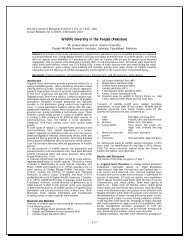
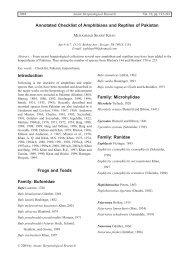

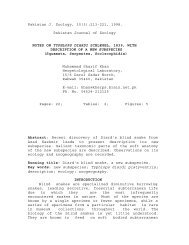


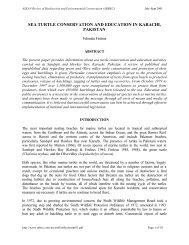
![Dureji (Ovis orientalis [vignei] blanfordi) - Wildlife of Pakistan](https://img.yumpu.com/11814520/1/190x245/dureji-ovis-orientalis-vignei-blanfordi-wildlife-of-pakistan.jpg?quality=85)
